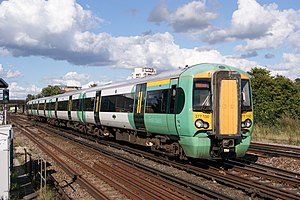
The British Rail Class 357Electrostar are alternating current (AC) electric multiple unit passenger trains (EMUs) built by Adtranz at its Derby Litchurch Lane Works, England, in two batches from 1999 to 2002 at a cost of approximately £292 million.
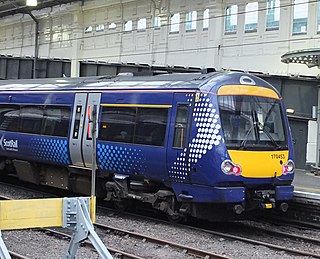
The British Rail Class 170 Turbostar is a British diesel multiple unit (DMU) passenger train designed and built by Adtranz, and later by Bombardier Transportation, at Derby Litchurch Lane Works.
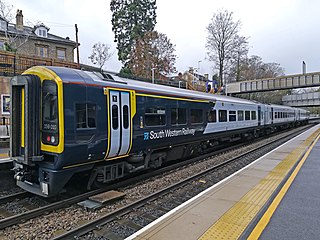
The British Rail Class 159 is a class of British diesel multiple unit passenger trains of the Sprinter family, built in 1989–1992 by British Rail Engineering Limited (BREL)'s Derby Litchurch Lane Works as Class 158. Before entering traffic, the original 22 units were modified at Rosyth Dockyard to Class 159 to operate services from London Waterloo to Salisbury and Exeter St Davids, replacing various locomotive-hauled passenger trains.
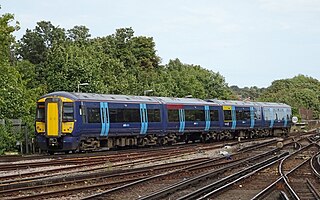
The British Rail Class 375 Electrostar is an electric multiple unit train that was built by Bombardier Transportation at Derby Litchurch Lane Works, from 1999 to 2005. The class form part of the Electrostar family of units, which also includes classes 357, 376, 377, 378, 379 and 387, the most numerous type of EMU introduced since the privatisation of British Rail.

The British Rail Class 377 Electrostar is a British dual-voltage electric multiple unit passenger train (EMU) built by Bombardier Transportation on its Electrostar platform at Derby Litchurch Lane Works from 2001 to 2014.

The British Rail Class 424 "Networker Classic" was a prototype electric multiple unit (EMU) built in 1997 by Adtranz at Derby Litchurch Lane Works from a Class 421 driving trailer vehicle.
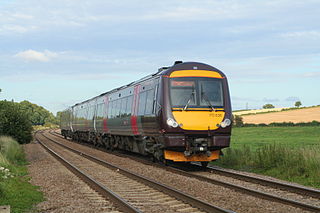
The Bombardier Turbostar is a family of diesel multiple unit (DMU) passenger trains that was built by ADtranz and later Bombardier Transportation at Derby Litchurch Lane Works in the United Kingdom between 1997 and 2011. The Turbostar was the first new train type to be introduced after the privatisation of British Rail. The first units were ordered by Chiltern Railways in 1996 and were designated Class 168. Since then the family has grown with the addition of the Class 170, Class 171, and the Class 172.
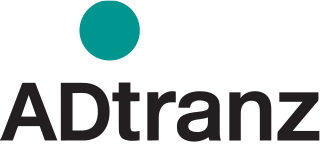
Adtranz was a multi-national rail transportation equipment manufacturer with facilities concentrated in Europe and the US. The company, legally known as ABB Daimler-Benz Transportation was created in 1996 as a joint venture between ABB and Daimler-Benz to combine their rail equipment manufacturing operations. In 1999, DaimlerChrysler bought ABB's shares and changed the company's official name to DaimlerChrysler Rail Systems. The company was acquired by Bombardier Inc. in 2001, which merged it into its Bombardier Transportation division, which became the largest rail equipment manufacturer in the world at the time, and was ultimately acquired by Alstom in 2021.
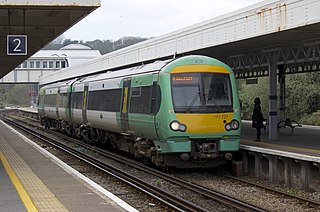
The British Rail Class 171 Turbostar is a type of diesel multiple unit (DMU) passenger train built by Bombardier Transportation at Derby Litchurch Lane Works in England. It is identical to the Class 170, except for the replacement of the BSI coupler with a Dellner coupler. This provision was made to allow emergency joining with Class 377 DC third-rail electric units, which Southern runs extensively on most lines. The units work on the southern regions of the British railway system, operating services from London Bridge to Uckfield and from Eastbourne to Ashford International, these routes being unelectrified between Hurst Green Junction and Uckfield and between Ore and Ashford International, respectively.

Gautrain is an 80-kilometre (50-mile) higher-speed express commuter rail system in Gauteng, South Africa, which links Johannesburg, Pretoria, Kempton Park and O. R. Tambo International Airport. It takes 15 minutes to travel from Sandton to O. R. Tambo International Airport on the Gautrain and 35 minutes from Pretoria in Tshwane to Park Station in Johannesburg. The Gautrain has 10 stations. Buses, shuttles and midibus services are available to transport passengers to and from all stations excluding the O. R. Tambo International Airport Station.
Bombardier Transportation was a Canadian-German rolling stock and rail transport manufacturer, with headquarters in Berlin, Germany. It was one of the world's largest companies in the rail vehicle and equipment manufacturing and servicing industry. Bombardier Transportation had many regional offices, production and development facilities worldwide. It produced a wide range of products including passenger rail vehicles, locomotives, bogies, propulsion and controls. In February 2020, the company had 36,000 employees, and 63 manufacturing and engineering locations around the world. Formerly a division of Bombardier Inc., the company was acquired by French manufacturer Alstom on 29 January 2021.
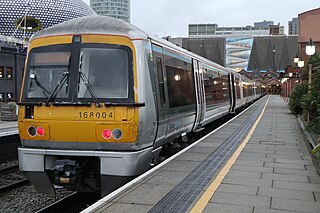
The Class 168Clubman is a British diesel multiple unit (DMU) passenger train used on Chiltern Line services between London Marylebone and the West Midlands. The trains were built by Adtranz at the Derby Litchurch Lane Works in several batches from 1998.
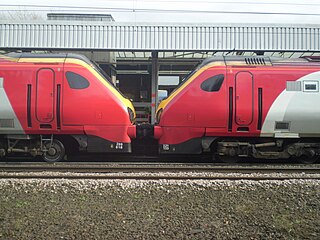
The Bombardier Voyager is a family of high-speed 125 mph diesel-electric multiple units built in Belgium by Bombardier Transportation, for service on the railway network of the United Kingdom. Construction of the Voyager family took place between 2000 and 2005, consisting of three classes - the Class 220 Voyager, the Class 221 Super Voyager and the Class 222 Meridian.

London Overground is a suburban rail network serving London and its environs. Established in 2007 to take over Silverlink Metro routes, it now serves a large part of Greater London as well as the home county of Hertfordshire, with 113 stations on the 6 lines that make up the network.
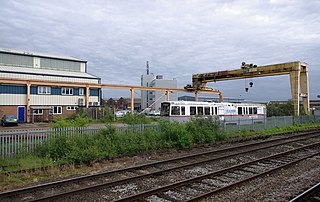
Derby Litchurch Lane Works, formerly Derby Carriage and Wagon Works, is a railway rolling stock factory in Derby, England. It was opened in the 19th century by the Midland Railway. The plant has produced rolling stock under the ownership of the Midland Railway. It is now owned by Alstom.

The Alstom Movia is a family of metro train cars designed by Adtranz and later built by Bombardier Transportation and Alstom. The structure and body shell are fully customisable for the needs of each system that orders it. Unlike most traditional metro trains, they usually have full-width gangways between carriages, allowing passengers to walk the entire length of the train. The design was developed by Adtranz, which was acquired by Bombardier in 2001. Since Alstom's acquisition of Bombardier in 2021, Alstom will be responsible for construction and delivery of future Movia metro train cars.

The British Rail Class 378 Capitalstar is an electric multiple unit passenger train specifically designed for the London Overground network. It is part of Bombardier Transportation's Electrostar family. A total of 57 five-car trains have been built – most of which were originally built as three- or four-car units.

The British Rail Class 172 is a British diesel multiple unit (DMU) passenger train from the Turbostar family, built by Bombardier Transportation's Derby Litchurch Lane Works for use on inner-suburban passenger services. The class is currently operated by West Midlands Railway.

The British Rail Class 379 Electrostar is an electric multiple unit (EMU) passenger train which was designed and built by Bombardier Transportation. The trains are part of the company's extensive Electrostar family.
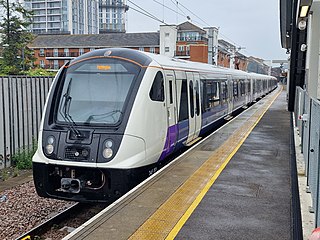
The Alstom Aventra is a family of electric multiple unit (EMU) passenger trains produced at Derby Litchurch Lane Works in the United Kingdom, originally by Bombardier Transportation and later by Alstom, as a successor to the Bombardier Electrostar. A large proportion of its design is based on the Electrostar, adding new technologies and achieving compliance with more stringent requirements and operator demands.
